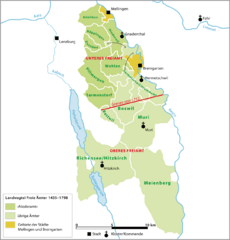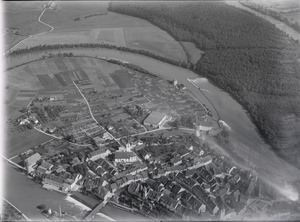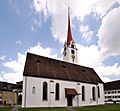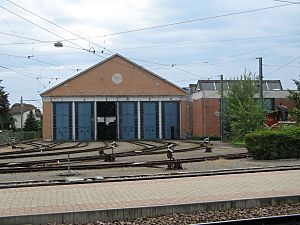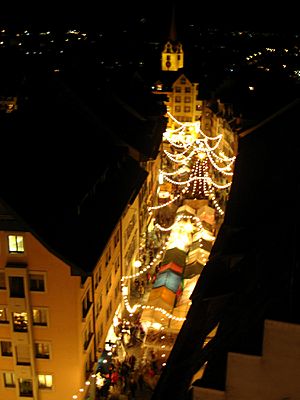Bremgarten, Aargau facts for kids
Quick facts for kids
Bremgarten
|
||
|---|---|---|
 |
||
|
||
| Country | Switzerland | |
| Canton | Aargau | |
| District | Bremgarten | |
| Area | ||
| • Total | 11.36 km2 (4.39 sq mi) | |
| Elevation | 386 m (1,266 ft) | |
| Highest elevation
(Spannhölzli)
|
475 m (1,558 ft) | |
| Lowest elevation
(Hegnau-Flussschlaufe)
|
358 m (1,175 ft) | |
| Population
(Dec 2020 )
|
||
| • Total | 8,415 | |
| • Density | 740.8/km2 (1,918.6/sq mi) | |
| Postal code |
5620
|
|
| Surrounded by | Eggenwil, Fischbach-Göslikon, Hermetschwil-Staffeln, Waltenschwil, Wohlen, Zufikon | |
Bremgarten is a town in the Swiss canton of Aargau. It is the main town of the Bremgarten district. The old part of the town, which dates back to the Middle Ages, is very important and is listed as a national heritage site. In 2013, Bremgarten was the first town in Europe to set up local rules about who could visit certain public places like libraries and swimming pools.
On January 1, 2014, the nearby town of Hermetschwil-Staffeln joined with Bremgarten.
Contents
History of Bremgarten
The area around Bremgarten was known by its name even before 1140. However, the town itself was founded almost a century later. Around 1230, a small settlement started near where Bremgarten is today. In 1238 or 1239, it was first written down as Bremegarten.
In 1258, Rudolf I of Habsburg gave Bremgarten the right to be a city. The town grew quickly and became an important place for markets. It also had a famous Latin school. Because Bremgarten was part of the Habsburg lands, its people fought on the Habsburg side in battles like Morgarten (1315) and Sempach.
In 1379, a courthouse was built in Bremgarten. This made it the center of a new legal area. Other villages joined this area over time. Berikon joined in 1374. Later, in 1410, Unterlunkhofen, Oberlunkhofen, Jonen, and Arni became part of it. More villages like Oberwil-Lieli (1429), Rudolfstetten-Friedlisberg (1430), and Huserhof (1482) also joined. This created two main areas: a "high" one and a "lower" one.
In 1415, the Old Swiss Confederation took over the Aargau region. Bremgarten became part of the Freie Ämter, which means "free bailiwicks." These areas were somewhat independent and could keep their own legal systems. Bremgarten, along with other towns like Mellingen and Muri, was ruled by some or all of the Swiss Confederates. When Bremgarten did not want to join the Confederation freely, it got involved in the Old Zürich War in 1443. During this war, the town was surrounded and captured.
Bremgarten played a big part in the Reformation. A famous Swiss reformer named Heinrich Bullinger was born there in 1504. In 1529, the town officially changed its religion from Catholicism. But in 1531, after the Battle of Kappel, Catholicism was brought back by force. Bullinger had to leave and moved to Zürich. There, he took over from Huldrych Zwingli as the city's leader after Zwingli died in battle.
Catholicism became less powerful after the second Villmerger War in 1712. Bremgarten then became part of the area controlled by Zürich, Bern, and Glarus. During the French Revolution, Louis-Philippe, who later became King of France, found safety in Bremgarten for a short time. Marshal André Masséna also set up his headquarters in Bremgarten before his troops defeated the Russian and Austrian armies near Zürich. When the Helvetic Republic was formed, Bremgarten was part of the short-lived Canton of Baden. In 1803, it joined the canton of Aargau.
The town grew a lot during the Industrial Revolution. Because of this growth, the old city wall was taken down. In 1876, Bremgarten was connected to the Swiss railway system. It wasn't until 1912 that the town was connected by rail to Dietikon and Wohlen.
After World War II, there was a huge increase in cars and trucks, just like everywhere else in Europe. Bremgarten is on the main road that connects Lenzburg to Zürich. Before a highway was built, this was one of the busiest roads in Switzerland. This caused a big problem because all the traffic had to go through a small wooden bridge in the old part of town. Even after the highway opened, the problem wasn't fully solved. Finally, in 1994, a bypass road was built. This made the old part of town quiet again, and it is now closed to cars.
Geography of Bremgarten
Bremgarten covers an area of about 8.02 square kilometers (3.1 square miles). About 10.1% of this land is used for farming, and 56% is covered by forests. Around 25.6% of the land has buildings or roads, and the remaining 8.4% is made up of non-productive areas like rivers.
The town is the capital of the Bremgarten district. The upper part of the town is located on hills above the Reuss river. The lower part of the town is right along the riverbanks.
Bremgarten's Coat of Arms
The blazon (description) of Bremgarten's coat of arms is a red lion standing on its hind legs on a silver background.
People of Bremgarten (Demographics)
Bremgarten has a population of about 8,000 people. As of 2008, about 21.9% of the people living there were from other countries. Over the past 10 years, the population has grown by about 17%. Most people in Bremgarten (86.2%) speak German. Albanian is the second most common language (3.0%), and Italian is third (1.9%).
Looking at the age groups in 2008:
- 10.4% of the population were children aged 0 to 9.
- 11.1% were teenagers aged 10 to 19.
- The adult population included 13.6% aged 20-29, 14.6% aged 30-39, 17.1% aged 40-49, and 13.4% aged 50-59.
- Older adults included 10.4% aged 60-69, 6.1% aged 70-79, 2.9% aged 80-89, and 0.5% aged 90 and older.
In 2000, there were many different types of homes. About 358 homes had 1 or 2 people, 1,283 homes had 3 or 4 people, and 623 homes had 5 or more people. On average, there were 2.12 people per home. In 2008, there were 549 single-family homes, which was about 18.2% of all homes.
In Bremgarten, about 69.1% of adults (aged 25-64) have finished either high school or gone on to higher education like university. In the 2008/2009 school year, there were 475 students in primary school and 186 students in secondary school. Also, 492 students were attending university or college-level schooling in the town.
Population Over Time
The chart below shows how the population of Bremgarten and Hermetschwil-Staffeln (before they merged) changed over the years:
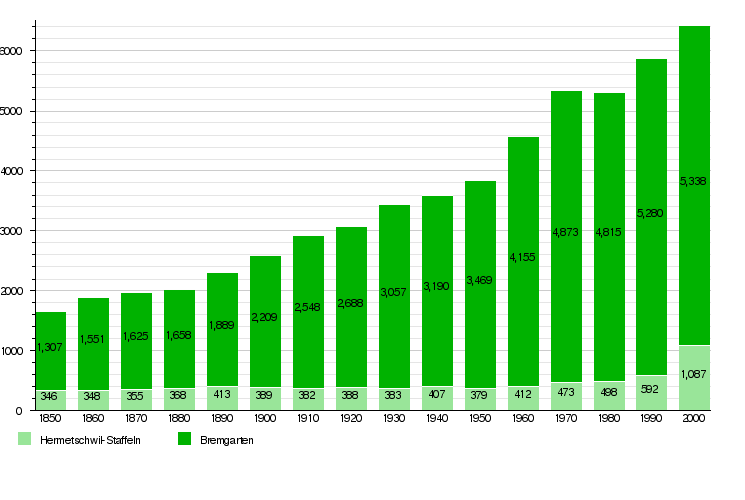
Important Heritage Sites
Bremgarten has nine places that are listed as important heritage sites of national significance in Switzerland. Before Hermetschwil-Staffeln joined in 2014, seven were in Bremgarten and two were in Hermetschwil-Staffeln.
These sites include:
- Two government buildings: the old Muri-Amthof at Antonigasse 2 and its addition at Antonigasse 4.
- Two churches: the Roman Catholic City Church with its St. Klara Chapel, and the St. Anna Chapel along with the Mother of God Chapel (Muttergottes) on Pfarrgasse / Kirchgasse.
- Two old defense structures: the Schlössli (a small castle) at Schlossgässli 2 and parts of the old city walls.
- One special house: the Weissenbach house at Antonigasse 24.
- From Hermetschwil-Staffeln: the Benedictine Convent of St. Martin, and the old Gasthaus (a type of hotel-restaurant) at Dorfstrasse 9.
The entire village of Bremgarten is also recognized as an important Swiss heritage site.
Economy of Bremgarten
In 2007, the unemployment rate in Bremgarten was 3.32%.
- In 2005, about 49 people worked in the primary sector (like farming). There were 9 businesses in this area.
- About 876 people worked in the secondary sector (like manufacturing). There were 75 businesses in this area.
- About 2,345 people worked in the tertiary sector (like services). There were 316 businesses in this area.
Bremgarten has many small and medium-sized businesses. Two well-known international companies are Georg Utz AG, which works with plastic technology, and Elro AG, which makes industrial kitchens. Like in many places, jobs in factories are slowly being replaced by jobs in the service sector. A famous company located here is LeShop.ch, an online grocery store with a large distribution center.
Transportation
Bremgarten is on the Bremgarten-Dietikon-Bahn railway line. This is a special narrow-gauge railway that connects Dietikon and Wohlen. There are five train stations within Bremgarten:
- Bibenlos-Sonnenhof
- Bremgarten (the main station)
- Bremgarten Obertor
- Bremgarten Isenlauf
- Bremgarten West
The main Bremgarten station also has the railway company's offices and train storage area. The trains run frequently, usually four times an hour, connecting Bremgarten to Dietikon and Wohlen.
Religion
Based on the 2000 census:
- About 51.0% of the people were Roman Catholic.
- About 21.5% belonged to the Swiss Reformed Church (Protestant).
- A small number (0.22%) belonged to the Christian Catholic faith.
Culture
Markets in Bremgarten
Bremgarten is famous for its four big markets. These markets bring tens of thousands of visitors and are very important for tourism.
- The Easter Market, held on Easter Monday, has been a tradition for over 750 years. It even includes a market for farm machinery.
- The Whitsun Market is held on Whit Monday and also has a long history.
- The Old Town Market takes place over two days at the end of October and focuses on arts and crafts.
- Since 1995, the Christchindlimärt (Christmas Market) has been held for four days in early December. With over 100,000 visitors and more than 300 stalls, it is now the largest Christmas market in Switzerland and is known internationally.
There are also weekly markets every Wednesday and Saturday from March to November.
Youth Culture
In June 1990, some young people started using an old textile factory that had been empty for 16 years. The next year, a group called Verein KulturZentrum Bremgarten KuZeB was formed. Their goal was to create a cultural center. Since 1992, this group has had an agreement to use the factory building. The KuZeB offers many cultural events, from concerts by alternative bands to readings and political talks.
Notable People from Bremgarten
- Werner Schodoler (1490-1541): A Swiss writer who wrote Swiss History, one of the first illustrated Swiss chronicles.
- Johannes Aal (around 1500–1553): A Swiss Catholic theologian, composer, and playwright.
- Heinrich Bullinger (1504–1575): A very important Swiss reformer and theologian during the Protestant Reformation.
- Johann Melchior Gletle (1626–1683): A Swiss organ player, music director, and composer.
- J.M. Brunswick (1819-1886): A Swiss Jewish immigrant to the U.S. who started the J.M. Brunswick Manufacturing Company.
- Hans Hutmacher (1921–1956): A Swiss racing cyclist who competed in the 1949 Tour de France.
- Cesar Lüthi (1930–2002): A Swiss businessman known for international sports marketing.
- Stephan Joho (born 1963): A Swiss former professional cyclist who competed in the 1984 Summer Olympics.
See also
 In Spanish: Bremgarten para niños
In Spanish: Bremgarten para niños






